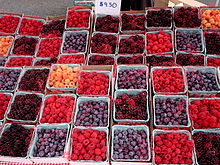植物化学物


植物化学物[1](英语:phytochemicals)又称植物性化合物[2]、植物生化素,简称植化素、植生素,是植物演化过程中维持其与周围环境相互作用的生物活性分子,也是存在于植物内的天然化学成分[3]。例如β-胡萝卜素,它存在于许多植物中。植生素通常指那些可能影响人体健康的物质,但是也可以指必须营养素。[4] 虽然有许多的科学家和官方建议要多从青菜和水果中摄取营养素[5] ,但是只有少许的证据能证明植生素能对生理能产生任何影响[4]。
用作替代疗法
几千年前就已经有许多植生素被当成药物使用,例如古希腊医师希波克拉底利用柳树的叶子治疗发烧。最初从白柳树中提炼出的水杨苷有消炎和止痛的功效,后来与其他物质混合制成非处方药阿司匹林。有研究指出某些蔬菜或水果中的植生素可以降低癌症发生的风险,那可能是由植物中的膳食纤维、多酚抗氧化剂和一些抗发炎的物质造成的。对于具体的植物化学物,例如可发酵膳食纤维,已被美国食品药品监督管理局允许用作有限的健康用品[6]。最初从植物中提取的植物生化素是一种治疗癌症的药物、紫杉醇,它由太平洋紫杉中被提取出来。提取自黄花蒿的青蒿素,抗恶性疟原虫,获得2015年诺贝尔生理学或医学奖。
可食用植物中的植物化学物有希望帮助预防疾病。来自于芸苔属植物(西兰花、花椰菜、卷心菜、羽衣甘蓝、抱子甘蓝)中的3,3-二吲哚基甲烷目前经测试可以防止喉乳头状瘤病(由人类乳突病毒引起)复发,目前正在用于治疗宫颈非典型增生(由人类乳突病毒引起的癌症前期疾病)的三期临床试验中,并正在进行对前列腺癌控制的临床试验[7]。
一些具有生理学性质的植物化学物可能是元素而不是复杂的有机分子。例如硒这种大量存在于水果与蔬菜中的元素,在人体中会参与到大量代谢途径之中,包括甲状腺激素的代谢与免疫功能[8]。特别地,它是一种必要营养素且在内源性抗氧化剂谷胱甘肽的酶促合成过程作为一种辅因子[9]。
临床试验及健康上的宣称
目前有很多植物化学物在对于多种疾病的临床试验中可能会表现出药物性质。例如,来自番茄中的番茄红素,已经经过对心血管病与前列腺癌的临床试验测试。然而这些研究表明并未达成获得足够的科学共识认为其对疾病有任何的效果[10]。美国食品药品监督管理局表态道:
“只有非常有限且初步的科学研究表明每周食用半茶杯或一茶杯的番茄和/或番茄酱可以降低患前列腺癌的风险。美国食品药品监督管理局得出结论:只有很少的科学证据支持这种宣称。”
同样的,尽管叶黄素与玉米黄质被猜测可以组织老年黄斑变性与白内障,然而只有不足的来自于临床试验的科学证据可以支持这一特定效果或健康上的宣称[11][12]。
食品加工
在新鲜采摘的植物里,它含有的植物生化素最为丰富,但当经过现代的食物处理过程,例如:烹调,都会令这些生化素被破坏或消失[13]。因此,经过工业化加工的食物很可能已丧失了相当的植物生化素,从而使其比未经处理的食物不健康。欠缺植物生化素的经处理食物,很可能是多种可预防的疾病的成因,又或可增加得病的风险[14][15]。幸运的是,番茄中的番茄红素的浓度再制成果汁或番茄酱后并不会有所改变[16],甚至会增加[17]。
参见
- 食品中的抗氧化剂列表
- 食品中的植物化学物质列表
- 食品中的植物化学物列表
- 营养学
- 植物化学
- 次级代谢产物
外部链接
- Phytochemicals and Cardiovascular Disease (页面存档备份,存于互联网档案馆)-美国心脏协会
- Phytochemical Database-美国农业部
- Phytochemicals at LPI (页面存档备份,存于互联网档案馆)-俄勒冈州立大学的Linus Pauling学院
- Phytochemical Image Database 中草药化学图像数据库 (页面存档备份,存于互联网档案馆) - 香港浸会大学中医药学院
参考资料
- ^ https://www.termonline.cn/word/1345967460519604230/1#s1
- ^ 存档副本. [2020-07-02]. (原始内容存档于2020-07-02).
- ^ 博客來書籍館:救命飲食:植物生化素. [2011-06-07]. (原始内容存档于2009-09-12) (中文(繁体)).
- ^ 4.0 4.1 Micronutrient Information Center, Linus Pauling Institute, Oregon State University. [2011-06-09]. (原始内容存档于2010-03-15).
- ^ Fruits and Veggies, More Matters. Centers for Disease Control and Prevention, US Department of Health and Human Services. 2010 [18 January 2010]. (原始内容存档于2010年1月7日).
- ^ US FDA, Health Claims that Meet Significant Scientific Agreement. [2011-06-09]. (原始内容存档于2009-05-15).
- ^ Diindolylmethane Clinical Trials. ClinicalTrials.gov, US National Institutes of Health, Department of Health and Human Services. 2010 [18 January 2010]. (原始内容存档于2010-03-16).
- ^ Brown, KM; Arthur, JR. Selenium, selenoproteins and human health: a review. Public health nutrition. 2001, 4 (2B): 593–9. PMID 11683552. doi:10.1079/PHN2001143.
- ^ Papp, LV; Lu, J; Holmgren, A; Khanna, KK. From selenium to selenoproteins: synthesis, identity, and their role in human health. Antioxidants & redox signaling. 2007, 9 (7): 775–806. PMID 17508906. doi:10.1089/ars.2007.1528.
- ^ Qualified Health Claims Subject to Enforcement Discretion, Docket No. 2004Q-0201 (页面存档备份,存于互联网档案馆), US Food and Drug Administration
- ^ US FDA, Qualified Health Claims: Letter of Denial - Xangold Lutein Esters, Lutein, or Zeaxanthin and Reduced Risk of Age-related Macular Degeneration or Cataract Formation (Docket No. 2004Q-0180)[1] (页面存档备份,存于互联网档案馆)
- ^ Krishnadev N, Meleth AD, Chew EY. Nutritional supplements for age-related macular degeneration. Current Opinion in Ophthalmology. May 2010, 21 (3): 184–9. PMC 2909501
 . PMID 20216418. doi:10.1097/ICU.0b013e32833866ee.
. PMID 20216418. doi:10.1097/ICU.0b013e32833866ee.
- ^ Cooking and nutrient loss, World's Healthiest Foods, (原始内容存档于2011-07-24)
- ^ Liu, RH. Potential synergy of phytochemicals in cancer prevention: mechanism of action. The Journal of nutrition. 2004, 134 (12 Suppl): 3479S–3485S. PMID 15570057.
- ^ Rao, AV; Rao, LG. Carotenoids and human health. Pharmacological research. 2007, 55 (3): 207–16. PMID 17349800. doi:10.1016/j.phrs.2007.01.012.
- ^ Agarwal, A; Shen, H; Agarwal, S; Rao, AV. Lycopene Content of Tomato Products: Its Stability, Bioavailability and in Vivo Antioxidant Properties. Journal of medicinal food. 2001, 4 (1): 9–15. PMID 12639283. doi:10.1089/10966200152053668.
- ^ Dewanto, V; Wu, X; Adom, KK; Liu, RH. Thermal processing enhances the nutritional value of tomatoes by increasing total antioxidant activity. Journal of agricultural and food chemistry. 2002, 50 (10): 3010–4. PMID 11982434. doi:10.1021/jf0115589.
| |||||||||||||||||||||||||||||||||||||||||||||||||||||||||||||||||||||
Text is available under the CC BY-SA 4.0 license; additional terms may apply.
Images, videos and audio are available under their respective licenses.
